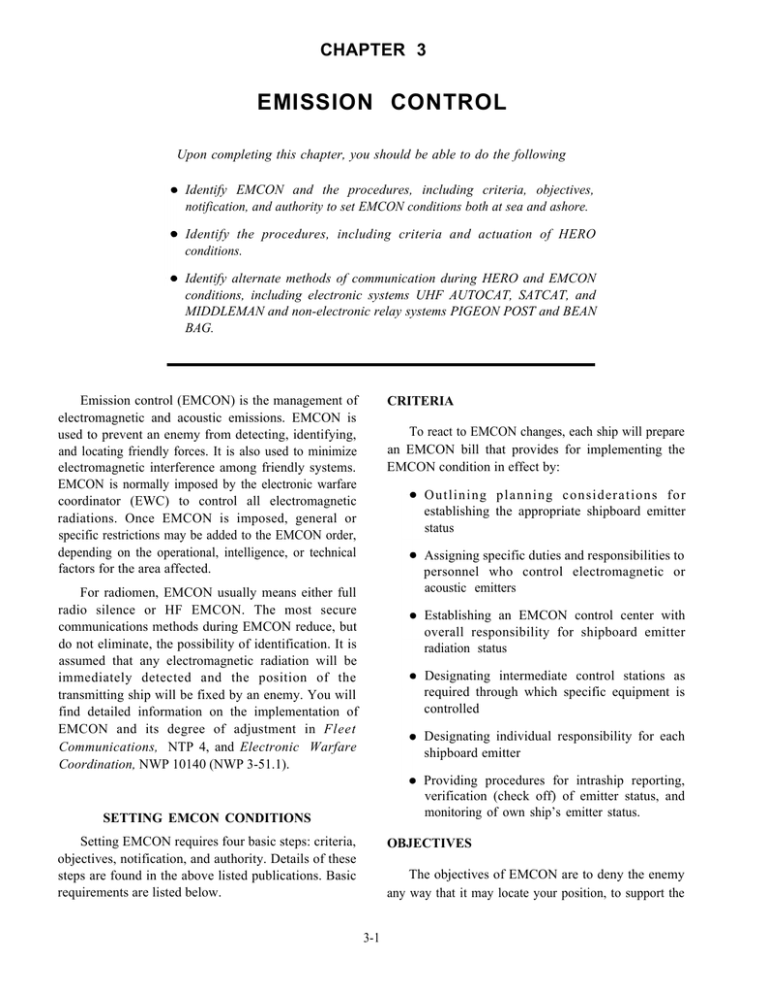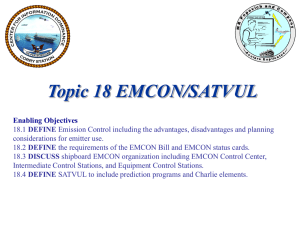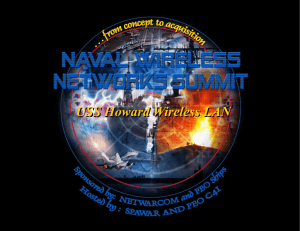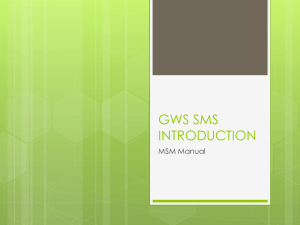EMISSION CONTROL CHAPTER 3
advertisement

CHAPTER 3 EMISSION CONTROL Upon completing this chapter, you should be able to do the following Identify EMCON and the procedures, including criteria, objectives, notification, and authority to set EMCON conditions both at sea and ashore. Identify the procedures, including criteria and actuation of HERO conditions. Identify alternate methods of communication during HERO and EMCON conditions, including electronic systems UHF AUTOCAT, SATCAT, and MIDDLEMAN and non-electronic relay systems PIGEON POST and BEAN BAG. Emission control (EMCON) is the management of electromagnetic and acoustic emissions. EMCON is used to prevent an enemy from detecting, identifying, and locating friendly forces. It is also used to minimize electromagnetic interference among friendly systems. EMCON is normally imposed by the electronic warfare coordinator (EWC) to control all electromagnetic radiations. Once EMCON is imposed, general or specific restrictions may be added to the EMCON order, depending on the operational, intelligence, or technical factors for the area affected. CRITERIA To react to EMCON changes, each ship will prepare an EMCON bill that provides for implementing the EMCON condition in effect by: Outlining planning considerations for establishing the appropriate shipboard emitter status Assigning specific duties and responsibilities to personnel who control electromagnetic or acoustic emitters For radiomen, EMCON usually means either full radio silence or HF EMCON. The most secure communications methods during EMCON reduce, but do not eliminate, the possibility of identification. It is assumed that any electromagnetic radiation will be immediately detected and the position of the transmitting ship will be fixed by an enemy. You will find detailed information on the implementation of EMCON and its degree of adjustment in Fleet Communications, NTP 4, and Electronic Warfare Coordination, NWP 10140 (NWP 3-51.1). Establishing an EMCON control center with overall responsibility for shipboard emitter radiation status Designating intermediate control stations as required through which specific equipment is controlled Designating individual responsibility for each shipboard emitter Providing procedures for intraship reporting, verification (check off) of emitter status, and monitoring of own ship’s emitter status. SETTING EMCON CONDITIONS Setting EMCON requires four basic steps: criteria, objectives, notification, and authority. Details of these steps are found in the above listed publications. Basic requirements are listed below. OBJECTIVES The objectives of EMCON are to deny the enemy any way that it may locate your position, to support the 3-1 maintains a single channel (FSK) termination, the circuit will be reestablished via the technical control center. efforts to disrupt the enemy’s electiveness, and to allow your actions to go unnoticed. To accomplish these objectives, EMCON conditions are designed with the following guidelines: AUTHORITY TO IMPOSE EMCON Minimize detection by enemy sensors EMCON is imposed as directed by the task group, squadron, or local instructions and standard operations procedures. Allow effective friendly command and control (C2) Support operations security (OPSEC) Support operational deception (OPDEC) HAZARDS OF ELECTROMAGNETIC RADIATION TO ORDNANCE (HERO) Minimize interference among friendly systems Degrade effectiveness of enemy C2 A danger of RF radiation is the risk of premature firing of ordnance or explosion of their warheads during loading and offloading operations. The hazard to electronic explosive devices (EEDs) occurs because of the heat generated by a current passing through the sensitive wires surrounding a temperature-sensitive explosive. If energy is dissipated into the wires, current will flow, the explosive will become hot, and an explosion can result. NOTIFICATION All ships need to keep command and control informed of any actions that may restrict, change, or alter in any way communication functions. The most fundamental of these actions follow: If at all possible, ships should notify the shore station of scheduled periods of EMCON due to radiation restrictions (HERO, HERF, RADHAZ) or other events (man aloft, aircraft operations, etc.) prior to the actual restrictive period. CRITERIA When ordnance or their warheads are loaded, unloaded, or transferred, shipboard HERO conditions may sometimes prohibit the transmission of RF frequency energy below 30 MHz. To maintain communication when HERO conditions are in effect, you will be required to use other frequencies or communication methods. If EMCON is imposed without notice, relay procedures to deliver outgoing traffic may be attempted. Shore stations must be alert to the sudden, unscheduled imposition of EMCON and the accompanying lack of any transmission from the ship. ACTUATION Transmitters and their antennas have only one purpose, which is to radiate electromagnetic energy. The initiating elements of ordnance items need only to be supplied with the proper amount of energy for an explosion to take place. RF energy may enter a weapon through a hole or crack in the skin of the weapon. RF energy may also be conducted into the weapon by the firing leads or other wires that penetrate the weapon enclosure. Guidance for each EMCON condition must be posted at each station or space with responsibility for setting or monitoring a given EMCON condition for the emitters. If the ship should enter EMCON without prior notice, the shore station will keep a listening monitor on the ship’s frequencies until the ship returns to the air. Additionally, a listening watch will be kept on the HICOM (covered and uncovered) net for possible contact from the ship. The probability of unintentional EED actuation is not totally predictable since detonation depends upon such variables as frequency, field strength, and environment. In general, ordnance systems that have proven to be susceptible to RF energy are most susceptible during loading, unloading, and handling in RF electromagnetic fields. Once a ship with a multichannel (VFCT) termination has returned to the air on previously assigned frequencies, the orderwire will be restored before the traffic circuits. If the ship 3-2 ALTERNATE METHODS A RATT circuit where all units transmit on one frequency and receive on another frequency. There will be times when you are unsure of the exact frequency of the active ordnance. In these circumstances you will be required to use alternate methods for communications. The alternate methods of relaying communications during HERO conditions include both electrical and nonelectrical relay systems. Non-Electronic Relay Systems There are two additional message relay systems. These systems, which utilize non-electronic relay systems, are PIGEON POST and BEAN BAG. Electrical l PIGEON POST provides a method of traffic To provide an uninterrupted flow of essential communications without violating HERO and EMCON limitations, techniques called AUTOCAT, SATCAT, and MIDDLEMAN were developed. These techniques extend the range of relay procedures using amplitude modulation UHF transmission via HF or satellite. In AUTOCAT, a ship provides the method for automatically relaying UHF transmissions; in SATCAT, an airborne platform provides the method. In MIDDLEMAN, the objective is obtained; however, the method requires an operator to copy the message with subsequent manual retransmission. delivery to shore by aircraft; l BEAN BAG provides a method for small ships to deliver message traffic via helo to shore or to a unit that is terminated full period for further transmission. SUMMARY EMCON is one of those facets of security that is required to properly perform your duties within general security guidelines. You must perform your duties in such a manner as to protect the integrity and overall value of secure communications. AUTOCAT, SATCAT and MIDDLEMAN use three different types of circuit configurations for reception and relay of UHF transmissions. These circuits are: A voice circuit where some units send and receive on one frequency, and other units send and receive on any other frequency; We have discussed a number of differing types of communications, but have not covered procedures in detail. Use of local instructions, Task Force/Group battle orders, or other methods of relaying communications is required. A voice circuit where all units transmit on one frequency and receive on another frequency; 3-3






